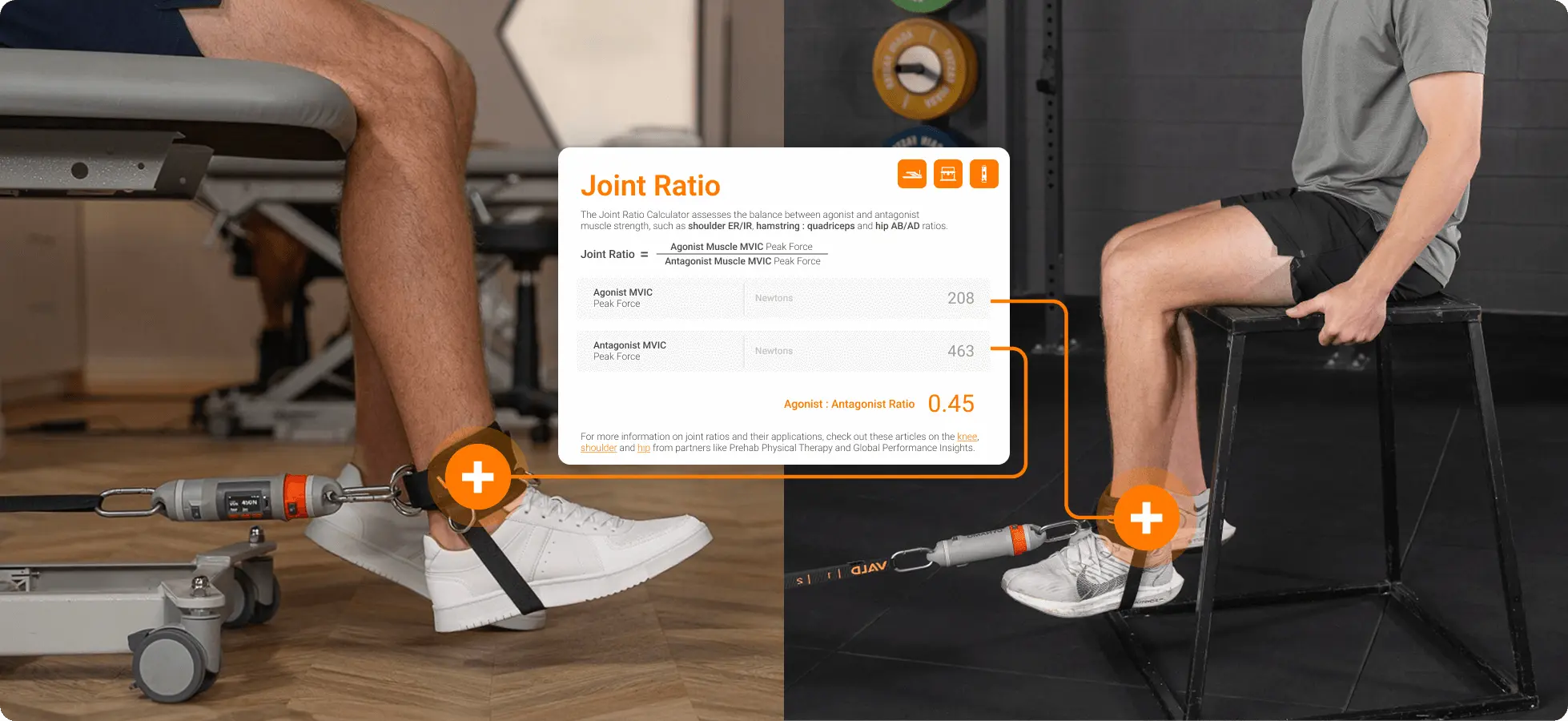MSK Calculators: Practical tools for clinical decision-making
Available in:
EN
In rehabilitation and performance settings, there is often a gap between collecting objective data and knowing what to do with it. Until now, there have not been readily available tools in our industry to help interpret this data – so we built them. MSK Calculators are designed to make common calculations simple, accessible and applicable to daily practice.
By turning raw numbers into meaningful ratios, indices and benchmarks, these calculators help guide clinical reasoning and decision-making related to treatment progression, return-to-sport readiness and program design.
This guide outlines when and how to use MSK Calculators for better outcomes.
Calculator Overview: Complete Toolkit
MSK Calculators allow practitioners to input key data and instantly generate standardized outputs that support next-step decisions. While simple to use, their application can be wide-ranging – especially when consistency in calculation methods matters.
MSK Calculators allow practitioners to input key data and instantly generate standardized outputs that support next-step decisions.
Some calculators are designed with the healthcare practitioner in mind (e.g., physical therapist, chiropractor or medical doctor). These calculators include:
| Calculator Name | Key Insights | Primary Use Cases | Equation |
| Impact Index | Functional landing capacity relative to bodyweight |
| Land and hold (peak drop landing force) / subject mass (body mass) |
| Joint Ratio Calculator | Muscle balance between agonist and antagonist |
| Agonist maximum voluntary isometric contraction (MVIC) peak force / antagonist MVIC peak force |
| Torque Calculator | Joint-specific strength normalized values |
| (MVIC assessment peak force × effort arm length) / body mass |
| Asymmetry Calculator | Left and right limb differences |
| ((Right value - left value) / (higher value)) × 100 |
| Relative Strength Calculator | Body weight-normalized strength comparisons |
| Peak force / body mass |
Other calculators are designed with the performance practitioner in mind. These include:
| Calculator Name | Key Insights | Primary Use Cases | Equation |
| Force-Rate Ratio | Strength vs. explosive capacity balance |
| (Peak force (rate of force development cueing) / peak force (maximal force cueing)) × 100 |
| Speed Calculator | Sprint performance metrics |
| Distance (between timing gates) / time (in seconds) |
| Eccentric Utilization Ratio (EUR) | Stretch-shortening cycle (SSC) efficiency |
| Countermovement jump (CMJ) jump height / squat jump (SJ) jump height |
Finally, some calculations are developed for ease of use across all populations, disciplines and groups. These calculators include:
| Calculator Name | Key Insights | Primary Use Cases | Equation |
| Load Conversion | Quickly convert from pounds to kilograms to Newtons |
| 1kg = 2.2 lbs = 9.8N |
| Distance Conversion | Quickly convert from millimeters, centimeters, inches, feet, yards, meters, kilometers and miles |
| See Calculator for all conversions |
| Return on investment (ROI) | Easily visualize and create a break-even analysis to better understand your organization’s finances |
| Investment price (monthly) / single session price |
Although all MSK Calculators are simple and intuitive, there are various examples of how popular calculators can be applied to gain practical insights for clinical and performance practitioners.
Calculators: Three Sample Applications
1. Joint Ratio Calculator
The joint ratio calculator compares the strength of opposing muscle groups – typically agonist to antagonist pairs – such as hamstrings to quadriceps at the knee. This ratio offers valuable insight into joint function, muscular balance and injury risk.
This can help practitioners:
- Assess risk factors for joint injury (e.g., hamstring strain, ACL injury)
- Monitor progress of strength interventions over time
- Compare against absolute values (e.g., peak force) to ensure strength and balance are restored

Sprinter performing knee flexion and extension on DynaMo, showing reduced hamstring strength.
Example:
A sprinter recovering from a hamstring injury shows a hamstring-to-quadriceps ratio of 0.45. Their rehabilitation professional uses the joint ratio calculator to track improvements in hamstring strength relative to quadriceps strength and guide progression toward return-to-sprint criteria, set for sprinters between 0.6 and 0.7.

2. Impact Index Calculator: Quantifying Real-World Load Capacity
The impact index calculator assesses impact load relative to body weight during a land-and-hold task. The results of this assessment are applicable to deceleration and other functional tasks such as jumping, stair navigation or change-of-direction movements.
This can help practitioners:
- Evaluate readiness for impact-based activities
- Guide progressive loading
- Link test results to real-world demands
- Flag potential overload risk
Example of two impact indices that have vastly different landing strategies.
Example:
A basketball player shows 5.6 times body weight impact on the right leg and 2.1 times on the left. The asymmetry points to eccentric strength deficits. The practitioner adjusts training and monitors changes over time.
3. EUR Calculator: Unlocking Elastic Energy Efficiency
The EUR calculator compares SJ and CMJ to evaluate elastic energy efficiency and SSC function.
This can help practitioners:
- Inform plyometric programming
- Track neuromuscular recovery
- Help optimize jump performance

A volleyball player showing an abnormal EUR, indicating that plyometric training may benefit sport performance.
Example:
A volleyball player shows an EUR of 0.95, indicating poor SSC use. The practitioner shifts focus to plyometric and reactive strength work and monitors progress through follow-up testing.
Conclusion: Accelerating Clinical Confidence
Although many blogs and articles exist describing metrics in detail, our industry has lacked actionable tools for calculating these metrics for sports performance and rehabilitation providers. The goal is simple: help practitioners make sense of their data and make decisions more confidently.

MSK Calculators help practitioners analyze metrics from force plates, timing gates, dynamometry and more.
These tools are not a replacement for clinical judgment, but they can make it easier to interpret results, track progress and guide treatment or training decisions. By using standardized calculations and benchmarks, tools like MSK Calculators help reduce guesswork and bring more consistency to how we interpret assessment data.
…tools like MSK Calculators help reduce guesswork and bring more consistency to how we interpret assessment data.
For more information on implementing MSK Calculators in your practice, visit valdhealth.com/calculators and bookmark it for easy access during your assessment sessions.
